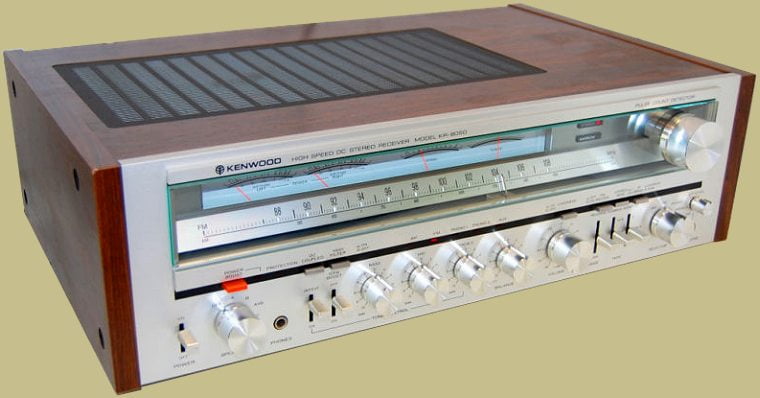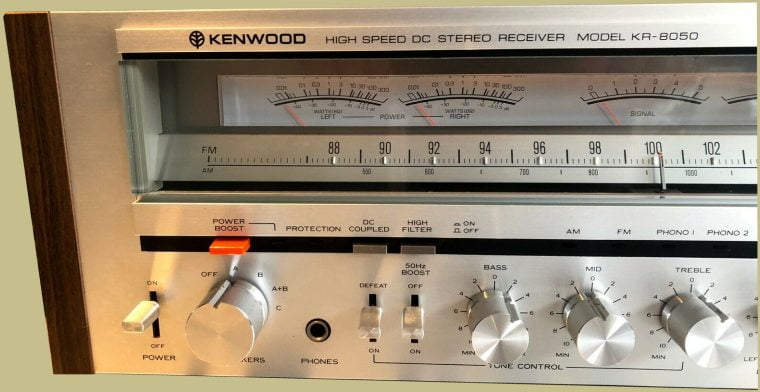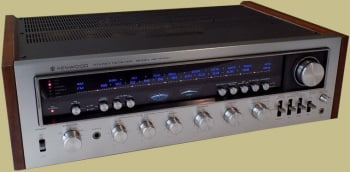
The Kenwood KR-8050 FM/AM Hi-Speed DC receiver as Kenwood called it was introduced in 1979. It was an advanced stereo electronically and fit into the monster receiver category by pushing out 120 watts per channel in ‘normal’ mode and 150 watts per channel when the ‘Power Boost’ feature was turned on. The Power Boost is, of course, that bright orange button on the left side of the front panel. Push that button and all hell breaks loose. Well, not really, but you do get an extra 30 wpc. The KR-8050 produces no more that 0.02% total harmonic distortion which is very good. The KR-8050 was part of Kenwood’s last line of silver faced receivers and retailed for a hefty $820.00.

The power boost feature works only with speakers that are higher than 8 ohms. Running the boost with 4 ohm speakers will result in the protection circuit engaging. Some 8 ohm speakers may have lower impedance at some frequencies which can also cause the protection circuit to activate. So, it should really only be used when you need the extra power and are driving 8 ohm or lower impedance (8+ ohm) speakers. Otherwise just leave it off so it doesn’t consume as much electricity.

One control that is a little confusing on the KR-8050 is the DC Coupled button. What does it do? Well, it’s basically what other manufacturers call a subsonic filter (technically an infrasonic filter) which filters out low frequencies in the inaudible range like rumble from a turntable. Why Kenwood labels it DC Coupled I’m not sure. I guess it sounds more impressive.
The tone controls on the Kenwood KR-8050 are extensive. Aside from the Bass, Mid and Treble controls there is also a defeat switch and a 50Hz Boost switch which can provide a low frequency boost at 50Hz when using smaller speakers or the room acoustics require it.
The Stereo Sens button is usually kept in the 2 position when a signal is strong enough to produce good stereo. If the signal is weak then try position 1.
The IF band selector switch is used when a really strong adjacent signal interferes with the signal you’re trying to receive. In that case switch it to Narrow. Otherwise just leave it on the Wide setting.

The Mix Level control is interesting. It lets you mix in a microphone input with whatever source music you are playing. You can control the volume of the mix. Somewhat similar to today’s karaoke. Increase the mix level and the mic volume will increase relative to the input source volume. Turn the Mix Level to min then plug in your mic. Then turn the Mix Level knob to set your input level.
The Kenwood KR-8050 has large, fast-acting, detailed power meters for both the left and right channels as well as signal strength and tuning meters. They are situated above the tuning dial which makes them easy to see.

Specifications:
- Tuning range: FM, MW
- Power output: 120 watts per channel into 8 ohms (stereo)
- 2 phono inputs
- Aux input
- 2 tape inputs
- Outputs for 3 sets of speakers
- Headphone jack
- Frequency response: 20Hz to 20kHz
- Total harmonic distortion: 0.02%
- Damping factor: 85
- Input sensitivity: 2.2mV (mic), 2.5mV (MM), 200mV (line)
- Signal to noise ratio: 85dB (MM), 108dB (line)
- Output: 200mV (line), 30mV (DIN)
- Dimensions: 571 x 172 x 411mm / 22 15/32 x 6 3/4 x 16 3/16 inches
- Weight: 18kg / 39.6 lbs
- Year: 1979-1980

Kenwood slapped the High Speed label on the KR-8050 and their other KR-xx50 receivers as well as their integrated amps that were on the market at the time. This was mostly a marketing tactic but their direct coupled amplifier design did utilize fast switching transistors which resulted in a faster ‘slew rate’ and better ‘transient response’. The KR-8050’s slew rate is +/- 200V/usec. Does this result in an audible difference? I’m not sure. It allegedly increases the clarity and crispness of the music. Either way, the High Speed label looks impressive on the front panel.

Equally impressive sounding is the Pulse Count Detector label at the top right of the front panel. The KR-8050 is a Kenwood so, of course, it has a fantastic tuner. Kenwood has always made good tuners and the KR-8050 tuner is no exception. It’s excellent. The Pulse Count Detector feature gives the KR-8050 it’s unparalleled signal-to-noise ratio and low distortion rate with regard to the FM signal. There are also dual-gate MOS FET’s in the front end for stellar sensitivity.
On the back panel there is a De-emphasis switch that has three settings. In the U.S. it should be set to 75. There are also connectors for three sets of speakers and three accessory plugs.

The Kenwood KR-8050 is a fine receiver. Overall it’s sound is more neutral and natural than say a Marantz 22xx series receiver so your ear may need to adjust. If you want to listen to FM then there aren’t many better (maybe the KR-9050 or KR-9600). On top of its stellar performance it is fairly rare too. They don’t come up for sale very often. So, for power, sound, and FM tuning it is top level. Some feel that it looks sterile and technical but others don’t mind the styling and love the large meters and orange boost button. If you see a KR-8050 at a reasonable price, get it. The power and tuner alone are worth it.
If you’re interested in seeing a restoration of a Kenwood KR-8050 with a lot of technical pics then check THIS page out.


I bought my KR8050 new, when they first came out. After an incident that took out several components in the amplifier, it has performed flawlessly ever since with various JBL speakers.
But now I’d like to add a subwoofer, and I made the mistake of purchasing a “powered ” one (Klipsch R-105W NA) before I discovered that there are no pre-outs on the receiver, just some A and B tape inputs, for both record and play.
As I am always up for a challenge, do you have any suggestions on how to make these two units play nice together? Maybe someway to bypass the subwoofer amplifier? I haven’t even plugged them in together yet, as I don’t want to toast either of them.
Thanks in advance,
TK
Tom.
Get a 1/4inch headphone to rca cable ,
connect to the sub.
I HAVE A BRAND NEW ONE 4 SALE CONTACT BOB AT RGENTILE1956@AOL.COM AND MAKE AN OFFER! HIGH BID WILL OWN THIS MONSTER!
Sad to say I am finally listing my KR 8050 … I got it when I was 16 and blasted many a Zeppelin. And rolling stones song, at some wild parties. Miami vice had nothing on us. There’s always a chance. I’ll change my mind and just look at the beauty of this unit until the end of time.